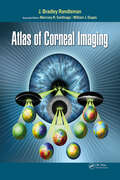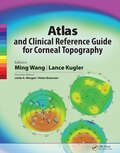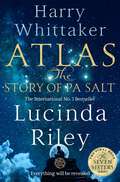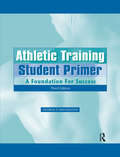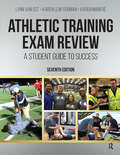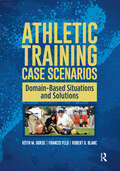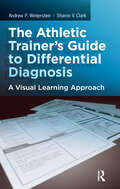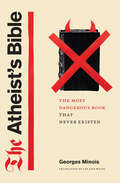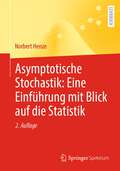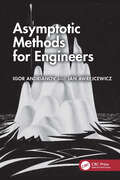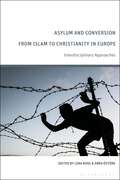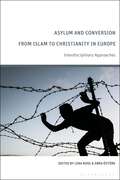- Table View
- List View
Atlas of Diagnostic Pathology in Nonhuman Primates
by Andrew D. Miller Ivanela Kondova-Perseng Keith G. MansfieldThe Atlas of Diagnostic Pathology in Nonhuman Primates offers the first extensively illustrated collection of classic lesions in nonhuman primate diseases and pathological conditions, compiled by an international team of expert contributors. Organized by infectious and noninfectious conditions, the atlas comprehensively covers viral, bacterial, fungal, and parasitic diseases, as well as nutritional, toxic, and metabolic causes, and genetic, age-related, neoplastic, and noninfectious inflammatory conditions. Since nonhuman primates are an indispensable resource for efficacy and safety evaluation of novel therapeutic strategies targeting clinically important human diseases, research with monkeys is critical to understand how to prevent and treat emerging infectious diseases such as Zika virus disease, Ebola, Middle East Respiratory Syndrome (MERS), COVID-19/SARS-CoV-2/coronavirus, pandemic flu, and many more. This book is intended to serve veterinary practitioners in university facilities, zoos, biotechnological and pharmaceutical companies, as well as clinicians, researchers, and students engaged in nonhuman primate research.
Atlas of Corneal Imaging
by J. Bradley RandlemanA comprehensive reference for physicians, surgeons, and trainees, Atlas of Corneal Imaging covers all aspects of corneal imaging from basic map interpretation to advanced diagnostic uses and features over 1200 illustrative images and figures representing a wide variety of devices and techniques.Drs. J. Bradley Randleman, Marcony Santhiago, and William J. Dupps Jr guide readers through the process of analyzing corneal images using a multitude of different techniques, technologies, and individual devices. This creates a complete picture of the cornea’s basic methods and pathological processes and allows readers to directly visualize how their technology would display the pathology in question.Atlas of Corneal Imaging is designed to help practitioners recognize subtle findings and evaluate signs of weakening or pathology, no matter how they present or what device is being used. Multiple iterations of the same clinical condition are shown with numerous complementary images for the same eye to provide a comprehensive presentation of each case.Chapters feature information on: Topographic patterns and mapping Corneal ectasia evaluations Cornea and refractive surgery evaluations Clinical correlations with corneal disorders Cornea and refractive surgery complications Evaluation for cataract surgery Atlas of Corneal Imaging fills a significant void in corneal imaging resources available today by presenting an image-first approach to understanding all the many different technologies for imaging the cornea.
Atlas of Corneal Imaging
by J. Bradley RandlemanA comprehensive reference for physicians, surgeons, and trainees, Atlas of Corneal Imaging covers all aspects of corneal imaging from basic map interpretation to advanced diagnostic uses and features over 1200 illustrative images and figures representing a wide variety of devices and techniques.Drs. J. Bradley Randleman, Marcony Santhiago, and William J. Dupps Jr guide readers through the process of analyzing corneal images using a multitude of different techniques, technologies, and individual devices. This creates a complete picture of the cornea’s basic methods and pathological processes and allows readers to directly visualize how their technology would display the pathology in question.Atlas of Corneal Imaging is designed to help practitioners recognize subtle findings and evaluate signs of weakening or pathology, no matter how they present or what device is being used. Multiple iterations of the same clinical condition are shown with numerous complementary images for the same eye to provide a comprehensive presentation of each case.Chapters feature information on: Topographic patterns and mapping Corneal ectasia evaluations Cornea and refractive surgery evaluations Clinical correlations with corneal disorders Cornea and refractive surgery complications Evaluation for cataract surgery Atlas of Corneal Imaging fills a significant void in corneal imaging resources available today by presenting an image-first approach to understanding all the many different technologies for imaging the cornea.
Atlas of Chinese Macrofungal Resources: Volume 1: Overview, Macrofungal Ascomycetes, Jelly Fungi and Coral Fungi
by Yu Li Taihui Li Zhuliang Yang Tolgor Bau Yucheng DaiThis book is part of the 4-volumes collection of Atlas of Chinese Macrofungal Resources . This atlas documented 1819 species (or varieties) in 509 genera of macrofungi known from China, which are, according to their morphological characteristics, practically divided into 10 groups, including 196 larger ascomycetes, 21 jelly fungi, 47 coral fungi, 637 polyporoid, hydnaceous and lephoroid fungi, 11 cantharelloid fungi, 653 agarics, 130 boletes, 75 gasteroid fungi, 16 larger pathogenic fungi on crops, and 33 larger myxomycetes.All species are evidenced with voucher sand photographs. About 370 of the listed species (occupying 1/5 of the totals pieces) have their type localities in China, among which over 260 species (accounting for 1/7 of the species) were firstly discovered and published by the present authors. Some of the species are endemic to China and East Asia. Introduction to all species are accompanied with color photographs showing their macro-morphology and (or) habitat. The macroscopic and microscopic diagnostic characters ecological habits, economic importance (edibility, medicinal availability or toxicity) and geographical distribution in China of all species are described in brief and easy-to-understand style. In the guide, the characteristics and using method of the book, related mycological vocabulary, common taxonomic techniques and positions of the fungal genera in modern taxonomic system are briefly introduced.The knowledge of this book should be interesting to mycologists, mycology fans and mushroom lovers, as well as researchers, teachers and students studying on edible fungi, plant pathology, healthcare and biomedicine sciences, bioresources and biodiversity, ecology and other related disciplines. It is an ideal reference for those who are interested in the Chinese macrofungi and larger slime molds. In this first volume, it covers Macrofungal Ascomycetes, Jelly Fungi and Coral Fungi.
Atlas and Clinical Reference Guide for Corneal Topography
by Ming Wang Lance KuglerCorneal topography has become essentially a pattern recognition trade, best learned by viewing multiple images of representative patterns. In spite of this, currently available topography books focus only on the technology behind topography, or a particular application of topography, as opposed to presenting a comprehensive collection of topographic patterns that provide quick, consistent pattern recognition and identification. Drs. Wang and Kugler, along with Drs. Morgan and Boerman, look to fill this void with Atlas and Clinical Reference Guide for Corneal Topography.Atlas and Clinical Reference Guide for Corneal Topography is the first corneal topography book that lends itself to efficient image search and reference for busy clinicians at chair side. Organized into both map-based and disease-based sections, the book allows for quick reference in busy clinical situations. Images come from the commonly used topographers, the Zeiss Atlas and the Oculus Pentacam, but the principles of pattern recognition can be applied to any topographer. Due to the text’s large collection of topographic images and corresponding corneal conditions, Atlas and Clinical Reference Guide for Corneal Topography can be used side by side with the topographer.Designed as both a learning tool for students and a reference for clinicians to use when faced with a challenging topography interpretation, Atlas and Clinical Reference Guide for Corneal Topography will be appreciated by a wide spectrum of eye care professionals. General ophthalmologists, cataract and refractive surgeons, corneal specialists, optometrists, and ophthalmology residents and students will benefit from this invaluable atlas for corneal topography.
Atlas and Clinical Reference Guide for Corneal Topography
by Ming Wang Lance KuglerCorneal topography has become essentially a pattern recognition trade, best learned by viewing multiple images of representative patterns. In spite of this, currently available topography books focus only on the technology behind topography, or a particular application of topography, as opposed to presenting a comprehensive collection of topographic patterns that provide quick, consistent pattern recognition and identification. Drs. Wang and Kugler, along with Drs. Morgan and Boerman, look to fill this void with Atlas and Clinical Reference Guide for Corneal Topography.Atlas and Clinical Reference Guide for Corneal Topography is the first corneal topography book that lends itself to efficient image search and reference for busy clinicians at chair side. Organized into both map-based and disease-based sections, the book allows for quick reference in busy clinical situations. Images come from the commonly used topographers, the Zeiss Atlas and the Oculus Pentacam, but the principles of pattern recognition can be applied to any topographer. Due to the text’s large collection of topographic images and corresponding corneal conditions, Atlas and Clinical Reference Guide for Corneal Topography can be used side by side with the topographer.Designed as both a learning tool for students and a reference for clinicians to use when faced with a challenging topography interpretation, Atlas and Clinical Reference Guide for Corneal Topography will be appreciated by a wide spectrum of eye care professionals. General ophthalmologists, cataract and refractive surgeons, corneal specialists, optometrists, and ophthalmology residents and students will benefit from this invaluable atlas for corneal topography.
Atlas: The epic conclusion to the Seven Sisters series (The Seven Sisters #8)
by Lucinda Riley Harry WhittakerTHE INSTANT #1 INTERNATIONAL BESTSELLERThe final novel in the Seven Sisters series is here. Spanning a lifetime of love and loss, crossing borders and oceans, Atlas: The Story of Pa Salt, co-authored by her son Harry Whittaker, draws Lucinda Riley's saga to its stunning, unforgettable conclusion.1928, Paris. A boy is found, moments from death, and taken in by a kindly family. Gentle, precocious, talented, he flourishes in his new home, and the family show him a life he hadn’t dreamed possible. But he refuses to speak a word about who he really is.As he grows into a young man, falling in love and taking classes at the prestigious Conservatoire de Paris, he can almost forget the terrors of his past, or the promise he has vowed to keep. But across Europe an evil is rising, and no-one’s safety is certain. In his heart, he knows the time will come when he must flee once more.2008, the Aegean. The seven sisters are gathered together for the first time, on board the Titan, to say a final goodbye to the enigmatic father they loved so dearly.To the surprise of everyone, it is the missing sister who Pa Salt has chosen to entrust with the clue to their pasts. But for every truth revealed, another question emerges. The sisters must confront the idea that their adored father was someone they barely knew. And even more shockingly: that these long-buried secrets may still have consequences for them today.In this epic conclusion to the Seven Sisters series, everything will be revealed.
Athletic Training Student Primer: A Foundation for Success
by Andrew P. WintersteinAthletic Training Student Primer: A Foundation for Success, Third Edition is a dynamic text that provides students with a foundation upon which they can build their athletic training knowledge and develop an authentic understanding of the rewards and challenges of the athletic training profession. The Third Edition of Athletic Training Student Primer: A Foundation for Success by Andrew P. Winterstein builds upon previous editions in providing a mix of foundational athletic training knowledge coupled with human interest information to help guide students in their decision-making process when contemplating a career. This Third Edition breaks the mold of other introductory athletic training texts by including answers to many "real-life" athletic training situations. The Third Edition is broken into four sections that cover all different aspects of the profession: Understanding athletic training Common injuries and conditions Planning, prevention, and care Preparing for success Further expanding the learning process, included with each new textbook purchase is access to a companion website that includes videos, a glossary, and various web resources.Updated Features Include: New injury spotlights for the upper and lower extremity and general medical conditions Updated information from athletic training students on keys to success New career spotlights from athletic trainers working in a broad range of career settings Updated information on historic changes in athletic training, including the upcoming transition to master’s degree for professional preparation Updated web resources Additional resources for instructors Complete redesign of text layout and updated images Athletic Training Student Primer: A Foundation for Success, Third Edition is a must have for students taking the first step into a career in athletic training.
Athletic Training Student Primer: A Foundation for Success
by Andrew P. WintersteinAthletic Training Student Primer: A Foundation for Success, Third Edition is a dynamic text that provides students with a foundation upon which they can build their athletic training knowledge and develop an authentic understanding of the rewards and challenges of the athletic training profession. The Third Edition of Athletic Training Student Primer: A Foundation for Success by Andrew P. Winterstein builds upon previous editions in providing a mix of foundational athletic training knowledge coupled with human interest information to help guide students in their decision-making process when contemplating a career. This Third Edition breaks the mold of other introductory athletic training texts by including answers to many "real-life" athletic training situations. The Third Edition is broken into four sections that cover all different aspects of the profession: Understanding athletic training Common injuries and conditions Planning, prevention, and care Preparing for success Further expanding the learning process, included with each new textbook purchase is access to a companion website that includes videos, a glossary, and various web resources.Updated Features Include: New injury spotlights for the upper and lower extremity and general medical conditions Updated information from athletic training students on keys to success New career spotlights from athletic trainers working in a broad range of career settings Updated information on historic changes in athletic training, including the upcoming transition to master’s degree for professional preparation Updated web resources Additional resources for instructors Complete redesign of text layout and updated images Athletic Training Student Primer: A Foundation for Success, Third Edition is a must have for students taking the first step into a career in athletic training.
Athletic Training Exam Review: A Student Guide to Success
by Lynn Van Ost Karen Lew Feirman Karen ManfriFor more than 20 years, Athletic Training Exam Review has empowered and enabled students to assess and evaluate their athletic training knowledge, skills, and decision-making abilities. Now, newly updated for its platinum anniversary, the Seventh Edition continues a tradition of excellence while serving as a premier guide to successfully achieving certification as an athletic trainer.The Seventh Edition serves as a comprehensive self-evaluation tool, elevating readers’ level of preparation for the BOC exam. This market-leading guide has made a positive impact on the athletic training profession by highlighting and improving students’ strengths and weaknesses.What’s inside: Updated study techniques and test-taking strategies An expanded overview of the exam format to assist in organization and planning More than 1,300 multiple-choice questions and nearly 100 true/false questions, updated and organized according to the BOC’s Practice Analysis, Seventh Edition Educational Domains Clinical decision-making questions testing the ability to make appropriate judgment calls using problem solving A skills assessment composed of 26 problems designed to test manual athletic training skills Scenario-based problems to strengthen critical-thinking abilities In addition to the updated content, the Seventh Edition also features a fully redesigned and expanded online test-taking experience, including: New user-friendly, mobile format 8 knowledge assessment tests—3 more than the previous edition! 5 unique true/false exams 20 total drag and drop identification photographs—8 more than the previous edition! 43 critical-thinking scenarios 3 clinical decision-making exams containing scenario-based exam questions 13 video segments with related questions for practicing evaluation and assessment Athletic Training Exam Review has assisted thousands of students and has become a hallmark text around the globe. Connecting the classroom with clinical education, this review tool is a timely and critical text that prepares students for their exam and career as an athletic trainer.
Athletic Training Exam Review: A Student Guide to Success
by Lynn Van Ost Karen Lew Feirman Karen ManfriFor more than 20 years, Athletic Training Exam Review has empowered and enabled students to assess and evaluate their athletic training knowledge, skills, and decision-making abilities. Now, newly updated for its platinum anniversary, the Seventh Edition continues a tradition of excellence while serving as a premier guide to successfully achieving certification as an athletic trainer.The Seventh Edition serves as a comprehensive self-evaluation tool, elevating readers’ level of preparation for the BOC exam. This market-leading guide has made a positive impact on the athletic training profession by highlighting and improving students’ strengths and weaknesses.What’s inside: Updated study techniques and test-taking strategies An expanded overview of the exam format to assist in organization and planning More than 1,300 multiple-choice questions and nearly 100 true/false questions, updated and organized according to the BOC’s Practice Analysis, Seventh Edition Educational Domains Clinical decision-making questions testing the ability to make appropriate judgment calls using problem solving A skills assessment composed of 26 problems designed to test manual athletic training skills Scenario-based problems to strengthen critical-thinking abilities In addition to the updated content, the Seventh Edition also features a fully redesigned and expanded online test-taking experience, including: New user-friendly, mobile format 8 knowledge assessment tests—3 more than the previous edition! 5 unique true/false exams 20 total drag and drop identification photographs—8 more than the previous edition! 43 critical-thinking scenarios 3 clinical decision-making exams containing scenario-based exam questions 13 video segments with related questions for practicing evaluation and assessment Athletic Training Exam Review has assisted thousands of students and has become a hallmark text around the globe. Connecting the classroom with clinical education, this review tool is a timely and critical text that prepares students for their exam and career as an athletic trainer.
Athletic Training Case Scenarios: Domain-Based Situations and Solutions
by Francis Feld Keith Gorse Robert BlancEvery case that athletic trainers respond to is unique, but by exposing themselves to a variety of scenarios, they can be prepared for almost any situation. Case studies are the easiest way to find this information, but oftentimes, they come in the form of informal anecdotes or only relate to very specific subjects. Athletic Training Case Scenarios: Domain-Based Situations and Solutions is designed to fill this gap by providing a large number of studies from all five of the domains of athletic training. Keith M. Gorse, Francis Feld, and Robert O. Blanc have gathered true-to-life scenarios for each of the five domains of athletic training, resulting in expert advice on the best response to many possible scenarios. These scenarios were shared by the certified athletic trainers who originally responded to them coming from their work in industrial settings, high schools, colleges, professional teams, and sports medicine clinics. Each scenario features the actual case as it was first assessed by the athletic trainer in order to give readers an opportunity to use their own judgment and decide the best course of action before the original athletic trainer’s own response and recommendations are given. Organized by domain, readers will be able to easily find examples of any case they could imagine. Each domain (prevention, evaluation and diagnosis, emergency care, treatment and rehabilitation, and organizational and professional health) has over a dozen scenarios designed to encourage critical thinking. This format gives readers the closest thing to a crash-course by exposing them to a diverse array of cases and situations. Athletic training students and clinicians will appreciate the wide range of cases presented in Athletic Training Case Scenarios: Domain-Based Situations and Solutions, providing them with the strong knowledge base they will need to respond to any situation they may experience themselves.
Athletic Training Case Scenarios: Domain-Based Situations and Solutions
by Francis Feld Keith Gorse Robert BlancEvery case that athletic trainers respond to is unique, but by exposing themselves to a variety of scenarios, they can be prepared for almost any situation. Case studies are the easiest way to find this information, but oftentimes, they come in the form of informal anecdotes or only relate to very specific subjects. Athletic Training Case Scenarios: Domain-Based Situations and Solutions is designed to fill this gap by providing a large number of studies from all five of the domains of athletic training. Keith M. Gorse, Francis Feld, and Robert O. Blanc have gathered true-to-life scenarios for each of the five domains of athletic training, resulting in expert advice on the best response to many possible scenarios. These scenarios were shared by the certified athletic trainers who originally responded to them coming from their work in industrial settings, high schools, colleges, professional teams, and sports medicine clinics. Each scenario features the actual case as it was first assessed by the athletic trainer in order to give readers an opportunity to use their own judgment and decide the best course of action before the original athletic trainer’s own response and recommendations are given. Organized by domain, readers will be able to easily find examples of any case they could imagine. Each domain (prevention, evaluation and diagnosis, emergency care, treatment and rehabilitation, and organizational and professional health) has over a dozen scenarios designed to encourage critical thinking. This format gives readers the closest thing to a crash-course by exposing them to a diverse array of cases and situations. Athletic training students and clinicians will appreciate the wide range of cases presented in Athletic Training Case Scenarios: Domain-Based Situations and Solutions, providing them with the strong knowledge base they will need to respond to any situation they may experience themselves.
An Athletic Trainers’ Guide to Sports Nutrition
by Damon AmatoAn Athletic Trainer’s Guide to Sports Nutrition fills the void of a subject area that is underrepresented in current athletic trainer curriculums despite its importance in the field. Damon Amato has created a text that can be easily read and understood by health care professionals yet is in-depth enough to create a solid understanding of how the body works, and easy enough to then pass on the information to athletes to help them eat ideally based on their specific sport, goal, and situation. Giving a physiology background is necessary to lay the foundation for understanding why certain recommendations in the text are given; however, only the necessary details are included to focus on what is pertinent for athletic trainers to understand while advising athletes.Some topics covered inside include: Basics of human nutrition Disordered eating and eating disorders in athletes Supplements Eating optimally for injury recovery Nutrient timing Special situations An Athletic Trainer’s Guide to Sports Nutrition gives athletic training clinicians and students the information and tools necessary to aid athletes in maintaining peak performance in nutrition, and fills the void left in the current athletic training curriculum.
An Athletic Trainers’ Guide to Sports Nutrition
by Damon AmatoAn Athletic Trainer’s Guide to Sports Nutrition fills the void of a subject area that is underrepresented in current athletic trainer curriculums despite its importance in the field. Damon Amato has created a text that can be easily read and understood by health care professionals yet is in-depth enough to create a solid understanding of how the body works, and easy enough to then pass on the information to athletes to help them eat ideally based on their specific sport, goal, and situation. Giving a physiology background is necessary to lay the foundation for understanding why certain recommendations in the text are given; however, only the necessary details are included to focus on what is pertinent for athletic trainers to understand while advising athletes.Some topics covered inside include: Basics of human nutrition Disordered eating and eating disorders in athletes Supplements Eating optimally for injury recovery Nutrient timing Special situations An Athletic Trainer’s Guide to Sports Nutrition gives athletic training clinicians and students the information and tools necessary to aid athletes in maintaining peak performance in nutrition, and fills the void left in the current athletic training curriculum.
The Athletic Trainer's Guide to Differential Diagnosis: A Visual Learning Approach
by Andrew P. Winterstein Sharon ClarkAs educators, we strive to teach students to think critically and to commit to a diagnosis, the ability to make that commitment is one of the most difficult steps for clinicians in training. With many possible injuries and conditions, and an equally large number of diagnostic elements, a clear and logical method is needed.The Athletic Trainer’s Guide to Differential Diagnosis: A Visual Learning Approach provides an approach that helps the reader sort through the possibilities and think about the clinical evaluation within a clinical thinking framework using a visual mapping approach.The Athletic Trainer’s Guide to Differential Diagnosis is not designed to be a “how-to” evaluation text. Rather, it is designed to create a framework that allows the reader to think differently about differential diagnoses, access existing knowledge in anatomy and clinical evaluation, and assess information for the purpose of making higher-order clinical decisions. Dr. Andrew P. Winterstein and Sharon V. Clark have organized The Athletic Trainer’s Guide to Differential Diagnosis by body part, as well as by location in the body. The reader will be able to examine the possible diagnoses by location and approach the evaluation in a more focused and organized fashion. This method of evaluation also allows the reader the opportunity to apply evidence-based principles to the clinical evaluation process.The Athletic Trainer’s Guide to Differential Diagnosis takes a visual learning approach with an emphasis on diagrams, tables, and boxes to illustrate the visual evaluation framework. In addition, each chapter offers a clinical case to provide a springboard for approaching the differential diagnosis process.The Athletic Trainer’s Guide to Differential Diagnosis: A Visual Learning Approach will enhance the athletic training student and clinician’s critical thinking skills, as well as be an excellent resource for self-assessment and preparation for certification.
The Athletic Trainer's Guide to Differential Diagnosis: A Visual Learning Approach
by Andrew P. Winterstein Sharon ClarkAs educators, we strive to teach students to think critically and to commit to a diagnosis, the ability to make that commitment is one of the most difficult steps for clinicians in training. With many possible injuries and conditions, and an equally large number of diagnostic elements, a clear and logical method is needed.The Athletic Trainer’s Guide to Differential Diagnosis: A Visual Learning Approach provides an approach that helps the reader sort through the possibilities and think about the clinical evaluation within a clinical thinking framework using a visual mapping approach.The Athletic Trainer’s Guide to Differential Diagnosis is not designed to be a “how-to” evaluation text. Rather, it is designed to create a framework that allows the reader to think differently about differential diagnoses, access existing knowledge in anatomy and clinical evaluation, and assess information for the purpose of making higher-order clinical decisions. Dr. Andrew P. Winterstein and Sharon V. Clark have organized The Athletic Trainer’s Guide to Differential Diagnosis by body part, as well as by location in the body. The reader will be able to examine the possible diagnoses by location and approach the evaluation in a more focused and organized fashion. This method of evaluation also allows the reader the opportunity to apply evidence-based principles to the clinical evaluation process.The Athletic Trainer’s Guide to Differential Diagnosis takes a visual learning approach with an emphasis on diagrams, tables, and boxes to illustrate the visual evaluation framework. In addition, each chapter offers a clinical case to provide a springboard for approaching the differential diagnosis process.The Athletic Trainer’s Guide to Differential Diagnosis: A Visual Learning Approach will enhance the athletic training student and clinician’s critical thinking skills, as well as be an excellent resource for self-assessment and preparation for certification.
The Atheist's Bible: The Most Dangerous Book That Never Existed
by Georges MinoisA comprehensive biography of the Treatise of the Three Impostors, a controversial nonexistent medieval book. Like a lot of good stories, this one begins with a rumor: in 1239, Pope Gregory IX accused Frederick II, the Holy Roman Emperor, of heresy. Without disclosing evidence of any kind, Gregory announced that Frederick had written a supremely blasphemous book—De tribus impostoribus, or the Treatise of the Three Impostors—in which Frederick denounced Moses, Jesus, and Muhammad as impostors. Of course, Frederick denied the charge, and over the following centuries the story played out across Europe, with libertines, freethinkers, and other “strong minds” seeking a copy of the scandalous text. The fascination persisted until finally, in the eighteenth century, someone brought the purported work into actual existence—in not one but two versions, Latin and French. Although historians have debated the origins and influences of this nonexistent book, there has not been a comprehensive biography of the Treatise of the Three Impostors. In The Atheist’s Bible, the eminent historian Georges Minois tracks the course of the book from its origins in 1239 to its most salient episodes in the seventeenth and eighteenth centuries, introducing readers to the colorful individuals obsessed with possessing the legendary work—and the equally obsessive passion of those who wanted to punish people who sought it. Minois’s compelling account sheds much-needed light on the power of atheism, the threat of blasphemy, and the persistence of free thought during a time when the outspoken risked being burned at the stake.
At home with the poor: Consumer behaviour and material culture in England, c.1650-1850 (Studies in Design and Material Culture)
by Joseph HarleyThis book opens the doors to the homes of the forgotten poor and traces the goods they owned before, during and after the industrial revolution (c. 1650–1850). Using a vast and diverse range of sources, it gets to the very heart of what it meant to be ‘poor’ by examining the homes of the impoverished and mapping how numerous household goods became more widespread. As the book argues, poverty did not necessarily equate to owning very little and living in squalor. In fact, its novel findings show that most of the poor strove to improve their domestic spheres and that their demand for goods was so great that it was a driving force of the industrial revolution.
At home with the poor: Consumer behaviour and material culture in England, c.1650-1850 (Studies in Design and Material Culture)
by Joseph HarleyThis book opens the doors to the homes of the forgotten poor and traces the goods they owned before, during and after the industrial revolution (c. 1650–1850). Using a vast and diverse range of sources, it gets to the very heart of what it meant to be ‘poor’ by examining the homes of the impoverished and mapping how numerous household goods became more widespread. As the book argues, poverty did not necessarily equate to owning very little and living in squalor. In fact, its novel findings show that most of the poor strove to improve their domestic spheres and that their demand for goods was so great that it was a driving force of the industrial revolution.
Asymptotische Stochastik: Eine Einführung mit Blick auf die Statistik
by Norbert HenzeDieses Lehrbuch liefert einen verständnisorientierten Einstieg in die asymptotische Stochastik. Es ist vom Niveau her zu Beginn eines Mathematik-Masterstudiums angesiedelt und deckt den Stoff ab, der in einer vierstündigen Vorlesung mit zweistündigen Übungen vermittelt werden kann. Einzelne Kapitel eignen sich zudem für Seminare am Ende eines Bachelorstudiums.Neben eher grundständigen Themen wie der Momentenmethode zum Nachweis von Verteilungskonvergenz oder dem multivariaten zentralen Grenzwertsatz und der Delta-Methode werden unter anderem Grenzwertsätze für U-Statistiken und der Satz von Donsker sowie die Brown'sche Brücke mit Anwendungen auf die Statistik behandelt. Das Buch schließt mit einem zentralen Grenzwertsatz für hilbertraumwertige Zufallselemente mit Anwendungen auf gewichtete L²-Statistiken. Ein besonderes Merkmal des Buches sind mehr als 130 Selbstfragen, die am Ende des jeweiligen Kapitels beantwortet werden, sowie mehr als 180 Übungsaufgaben mit Lösungen. Hierdurch eignet sich dieses Werk sehr gut zum Selbststudium.Die 2. Auflage ist vollständig durchgesehen und thematisch unter anderem um die starke Konsistenz der Maximum-Likelihood-Schätzung sowie zentrale Grenzwertsätze für Dreiecksschemata von Zufallsvektoren und hilbertraumwertigen Zufallsvariablen erweitert. Hinzugekommen sind auch weitere Beispiele sowie 11 neue Aufgaben mit Lösungen.
Asymptotic Methods for Engineers
by Igor V. Andrianov Jan AwrejcewiczAsymptotic Methods for Engineers is based on the authors’ many years of practical experience in the application of asymptotic methods to solve engineering problems.This book is devoted to modern asymptotic methods (AM), which is widely used in engineering, applied sciences, physics, and applied mathematics. Avoiding complex formal calculations and justifications, the book’s main goal is to describe the main ideas and algorithms. Moreover, not only is there a presentation of the main AM, but there is also a focus on demonstrating their unity and inseparable connection with the methods of summation and asymptotic interpolation.The book will be useful for students and researchers from applied mathematics and physics and of interest to doctoral and graduate students, university and industry professors from various branches of engineering (mechanical, civil, electro-mechanical, etc.).
Asymptotic Methods for Engineers
by Igor V. Andrianov Jan AwrejcewiczAsymptotic Methods for Engineers is based on the authors’ many years of practical experience in the application of asymptotic methods to solve engineering problems.This book is devoted to modern asymptotic methods (AM), which is widely used in engineering, applied sciences, physics, and applied mathematics. Avoiding complex formal calculations and justifications, the book’s main goal is to describe the main ideas and algorithms. Moreover, not only is there a presentation of the main AM, but there is also a focus on demonstrating their unity and inseparable connection with the methods of summation and asymptotic interpolation.The book will be useful for students and researchers from applied mathematics and physics and of interest to doctoral and graduate students, university and industry professors from various branches of engineering (mechanical, civil, electro-mechanical, etc.).
Asylum and Conversion to Christianity in Europe: Interdisciplinary Approaches
by Lena Rose and Ebru ÖztürkDrawing together previously disjointed scholarship on the topic of asylum and conversion from Islam to Christianity, this book shows how boundaries of belonging are negotiated between Middle Eastern ex-Muslim asylum seekers, church representatives, lawyers, legal decision-makers and policymakers. With case studies from European countries such as Germany, Austria, Finland and Sweden, the book takes an interdisciplinary approach including ethnographic and other qualitative research, discourse analysis and case law analysis, to explore the complexities of the phenomenon of asylum and conversion from Islam to Christianity.This book is an authoritative resource for academic scholars in fields as diverse as migration and refugee studies, anthropology, sociology, religious studies, law and socio-legal studies, as well as legal and religious practitioners.
Asylum and Conversion to Christianity in Europe: Interdisciplinary Approaches
Drawing together previously disjointed scholarship on the topic of asylum and conversion from Islam to Christianity, this book shows how boundaries of belonging are negotiated between Middle Eastern ex-Muslim asylum seekers, church representatives, lawyers, legal decision-makers and policymakers. With case studies from European countries such as Germany, Austria, Finland and Sweden, the book takes an interdisciplinary approach including ethnographic and other qualitative research, discourse analysis and case law analysis, to explore the complexities of the phenomenon of asylum and conversion from Islam to Christianity.This book is an authoritative resource for academic scholars in fields as diverse as migration and refugee studies, anthropology, sociology, religious studies, law and socio-legal studies, as well as legal and religious practitioners.

